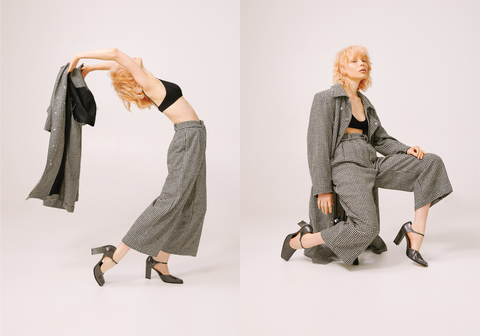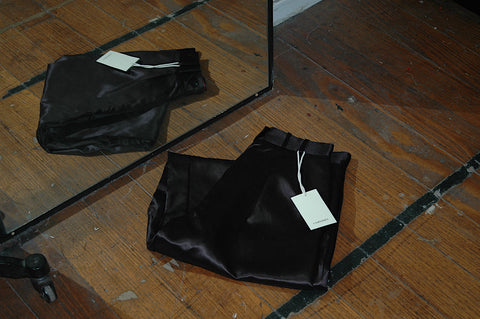How fashion can play a role in positive sexual self esteem; from the bedroom to the boardroom.
Introducing Laura Miano, a student sexologist studying a master’s program in sexual and reproductive health at the University of Sydney. Currently she works as a Sex Therapist in training for Chantelle Otten and writes weekly articles for a men’s digital publication, Man of Many. Before entering Sexology, Laura studied Textiles and Merchandising and worked in the fashion industry for a number of years. Following this, she headed back to school to study an undergraduate Psychology degree and made the decision to pursue a career in Sexology.
Laura’s change of career direction was sparked by her interest in challenging pre-existing constructs surrounding sex and relationships. She is specifically interested in how we can foster open and honest communication within relationships about our sexuality, to celebrate sexual desires rather than demonise them. Laura notes that the growing trend of non-monogamy and open relationships demonstrates a shift in our culture toward greater acceptance of desires - this movement of sexual acceptance is one that she hopes to contribute to. Additionally, she also wants to focus on empowering women to feel equally as entitled to pleasure as men and encourage them to pursue their right for pleasure in all sexual encounters.
What role can fashion play in positive sexual self-esteem?
Clothing covers our body, and our body is the center of our sexual selves. Through the use of different fabrics, shapes and materials an individual may choose to highlight or de-emphasise a certain area of their body. As fashion can act as a tool for self-expression, it facilitates an opportunity to communicate with the world that we feel comfortable and sexy within our own skin.
This may be communicated with a low-cut neckline, a figure-hugging garment shape or a fine fabric that contours certain body parts like the nipple. There are also more unassuming representations of positive sexual self-esteem such as a loose-fitting pant or an edgy jacket. For some women, this may signify a rejection of patriarchal values, which promote ‘beautifying’ women, allowing them to feel empowered, feel a sense of control and take ownership over their own manifestation of sexuality.
Finally, self-esteem functions through a feedback loop where we feel good about ourselves, so we behave in a way that aligns with these beliefs which then reaffirms these beliefs and maintains them. In this instance of fashion and sexual self-esteem, someone with a high degree of sexual self-esteem may dress in a way that makes them feel sexy, which then feeds-back and maintains their high self-esteem. This demonstrates just how integral the role of fashion has to foster a healthy sexual relationship with ourselves.
We’ve seen a progressive step towards more inclusivity and diversity within the lingerie sector, with the promotion of body positivity and sexual health at the forefront. However, how do you see that being translated into the wider stream of apparel on a more accepting and open level?
Lingerie and swimwear labels such as Youswim, Shoparq and JBC lingerie have excellently promoted the message that every shape is beautiful, and every person is sexual. With the body positivity movement in full motion, I can certainly see the apparel sector following a similar path. Considering that the lingerie sector is one of the most rigidly exclusive, if plus size women and women with disabilities have gotten down to their underwear, posed erotically and had their photo posted to the harshest of communities like Instagram, the hardest battle has already been fought.
With so much community support for the lingerie brands who are doing this kind of thing, I can only see apparel brands achieving the same successful.
How do you cultivate a positive sense of sexuality in yourself?
I cultivate a positive sense of sexuality by paying attention to my sexual accelerators and brakes – essentially, any area of my life that (in psychology terms) excites or inhibits my sexuality and sends a message to my sexual system to turn on or off.
Sexual accelerators may include candles, a certain scent, a specific pose or being touched in a particular way. Other accelerators may be 8 hours sleep, a day out with friends, eating good food, getting your hair done or spending some healthy time away from your partner. While it might not seem obvious, the latter can have a huge impact on our sexuality by putting us in a better mood, promoting a balanced lifestyle or allowing us a moment to crave our partners. It’s important to identify these areas in your life that have a direct or indirect impact on supporting your sexuality and put in the effort to increase as many accelerators as you can.
On the other hand, your sexual brakes might be a bad kiss, having the lights off/on, insufficient foreplay or a lack of emotional connection. More indirectly, sexual brakes may be too much partying, too much coffee, a long day at work, stress or illness. These inhibitors function by reducing your sense of sexuality therefore minimizing as many sexual brakes as possible will increase the likelihood of switching your sexual system on.
When it comes to each individual and cultivating their own positive sense of sexuality, everyone’s accelerators and brakes will vary. They may be completely different (or opposite) to the one’s I’ve mentioned. What’s important is identifying each of them and then working to increase or reduce them.

A women's value has often been derived from the opinions of men due to the many positions of power they hold. Do you think regaining our ownership of sensual femininity through dress can help women redefine their sense of worth not just in the bedroom, but also in the boardroom?
While taking ownership of our sensual selves and expressing it through fashion, we can easily translate to a heightened sense of self-worth in the bedroom. However this narrative is less intuitive in the context of the boardroom. If sensuality can add to our self-worth as lovers and partners then why shouldn’t it also add to our self-worth as co-workers, business owners and leaders? At what point does dressing proudly as a sensual female go from empowering to unnerving?
Traditionally, the boardroom has been reserved for suits – a hallmark of masculinity that women have assimilated to. But in our changing cultural climate, there should be more room made for the sensual female who want to embrace their femininity and lead the boardroom at the same time.
It goes without saying that some women might feel pressure to reject their femininity when in a room filled with men and instead appeal to their masculine side. When their career is on the line, some aren’t left with much choice.
However, it’s important that each woman honors her authentic femininity. The more proudly feminine women we see in leadership roles, the more normalized it will become.
So, can regaining our ownership of sensual femininity through dress help redefine our sense of self worth in the boardroom? Absolutely it can. The more feminised the boardrooms become, the more women can embrace their sensual selves and channel it toward achieving their success.
Do you think encouraging men to participate in an increased freedom of expression, in the bedroom and in dress, can aid the debate on equality in the workplace?
Definitely! The boardroom was built around masculinity and until recent times was reserved only for the masculine people among us. But masculinity no longer defines all men, including heterosexual men, and if men were comfortable with embracing and expressing their idiosyncrasies, it would help to facilitate change in the boardroom. Therefore allowing people of different sexual orientation and gender to feel welcome and confident ensuring they belong there too.
For some men, this might be incredibly daunting but one way to embark on a path of genuine self-expression is behind closed doors, with a trusted partner, in the context of the bedroom. Here a man can explore and test his boundaries. He may discover he enjoys anal erotica or that he likes his nipples sucked – all of which break the masculine stereotype.
From here, men can use this new ability to self-explore and translate it to the boardroom. From painted nails to flamboyant clothing, each quirk we see on leadership teams will normalise individuality and challenge our existing concept of who belongs in the boardroom.




